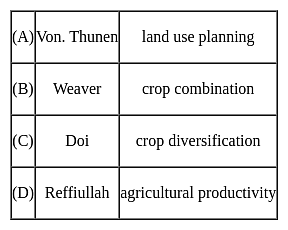TS SET Paper 2 Mock Test - 1 (Geography) - TS TET MCQ
30 Questions MCQ Test - TS SET Paper 2 Mock Test - 1 (Geography)
Consider the following statements about earthquake-
1. The point where the energy is released is called the focus of an earthquake, alternatively, it is called the epicenter.
2. The point on the surface, nearest to the focus, is called the hypocentre.
3. All-natural earthquakes take place in the lithosphere.
4. The most common ones are tectonic earthquakes. These are generated due to the sliding of rocks along a fault plane.
Which of the statements given above is/are not correct?
People move from rural to urban areas mainly for which of the following reasons?
(A) In search of employment
(B) In search of education
(C) In search of better health facilities
(D) In search of better accommodation
| 1 Crore+ students have signed up on EduRev. Have you? Download the App |
The swamp forests of India are found in delta of
Match List-I with List-II and select the correct combination

Choose the correct answer from the options given below:
As the temperature of the black body increases,the dominant wavelength of the emitted radiation according to Wein's displacement law is:

Which among the following is / are correct statements with respect to Shifting Cultivation as practiced in India?
- India’s largest area under shifting cultivation is in the state of Arunachal Pradesh
- In recent years, the cycle of shifting cultivation on a particular land has reduced drastically
Select the correct option from the codes given below:
i. Sunspots are features on the solar surface which appears as dark spot
ii. Sunspots are huge magnetic storms that occur on sun’s surface.
Choose the correct options:
Assertion A): The ecosystem surrounding a river gets damaged due to construction of a dam.
Reason R): The area gets inundated with large volume of water.
Choose the correct code:
Match the List-I with List-II two.

Choose the correct answer form the code given below:
Assertion A): Mapping of landslide prone areas and construction of houses, felling of trees and grazing in landslide prone areas should be prohibited.
Reason R): Afforestation in the vulnerable areas is an effective way of durable landslides control.
The following pairs are given about the contribution of geographer's in Agricultural geography and find out which is not correct?


According to the data, released by housing and urban poverity alleviation ministry, which state has the maximum number of slums?
a) Potholes and Plunge pools are found in the upper course of the river.
b) During the formation of meanders, the river does the erosional work on the convex bank and the depositional work on the concave bank.
c) A large number of tributaries joining the main river also lead to the formation of Deltas.
d) Braided stream is that which gets divided into several networks due to excess deposits on the river plain.
Which of the following statements are correct?
Which of the following statement is not correct about andesitic or acidic lava?
Consider the following statements:
1. India's first solar-wind hybrid plant is located in Maharashtra.
2. Diu is the first solar-powered island in India.
3. India's first village to be powered by solar all day is located in Gujarat.
Which of the statements given above are correct?























